|
|
July 8th, 2012
Although not one of the most rabid western Cape listers, I decided to head out to Klipheuwel on Saturday morning to catch up with the Great-spotted Cuckoo that was found earlier in the week.

The Atlas of the Birds of the Southwestern Cape (Hockey et al, 1989) says this about the species’ status in the region:
Rare summer visitor, no breeding recorded during the atlas period. Recorded from only four localities in the drier areas of the east and north. All records within the period August to December. Normally occurs in savanna habitats and is rare south of the Orange River. The principal brood hosts are crows and starlings: in the eastern Cape the Pied Starling is the main host, and Great-spotted Cuckoos in the SW Cape have been observed inspecting nest holes of this species: may occasionally breed in the region.
The bird at Klipheuwel appears quite at home; it spends a lot of its time in an open field gorging itself on small caterpillars. The bird is a sub-adult – it’s still showing some rusty brown markings in the primaries – visible in the dodgy shot below.

Other species recorded while watching the cuckoo included: Large-billed Lark, Red-capped Lark, Southern-masked Weaver, Cape Weaver, Pied Starling, Hadeda Ibis, African Fish Eagle, Common Starling, Cattle Egret and Cloud Cisticola.

David Winter
October 14th, 2011
Graham Bull has again seen a Eurasian Oystercatcher at Langebaan Lagoon, West Coast National Park. The bird apparently spends most of its time north of Seeberg hide. I wonder if this is the same bird that Graham reported in January this year?
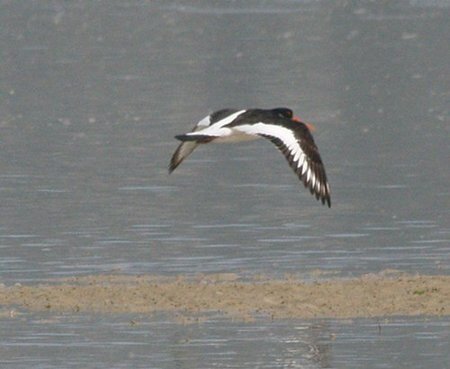
Thanks Graham.
David Winter
January 29th, 2011
Graham Bull emailed me these images of a Eurasian Oystercatcher he photographed at Langebaan Lagoon on Tuesday 25 January. The bird was about 1km north of Seeberg hide.
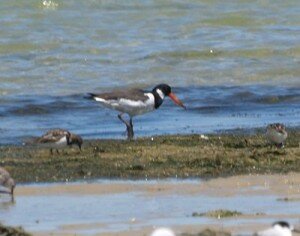
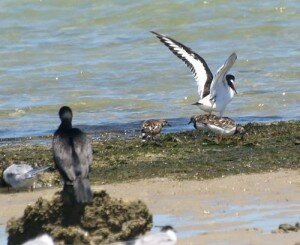
Great record Graham and thanks for submitting your photos.
David Winter
January 21st, 2011
A short raptor watch at Kirstenbosch Botanical Gardens on Saturday 15 January 2011 really turned up the goods. I always feel slightly deprived when a summer passes and I haven’t seen at least one Honey Buzzard on the Cape Peninsula. Last year was one of those where, despite putting in some time at Kirstenbosch and Newlands Forest, no Honeys were recorded.
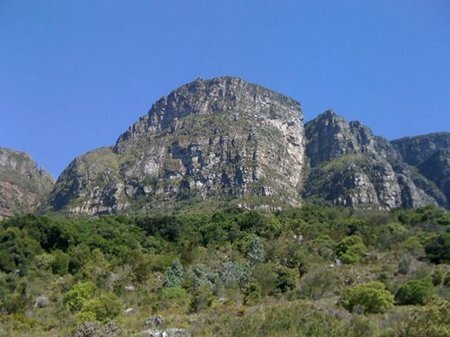
I’m pleased to report a different state of affairs this year. No sooner than 5 minutes after arriving at Kirstenbosch on Saturday (10:15am) an immature Honey Buzzard caught my attention. I was far from prepared for this early kick-off and only managed to rattle off a couple of shots before my camera’s card was full. Nevertheless, I managed to capture this image, which shows the diagnostic features.
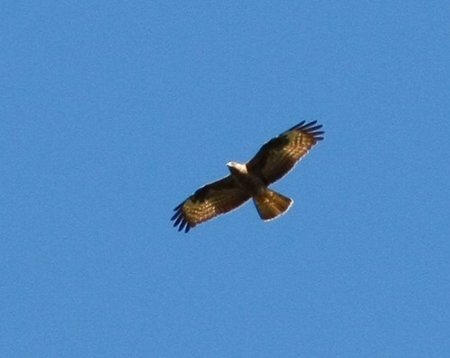
Honey Buzzard (immature)
I’m amazed how frequently I see African Harrier Hawk in the Southern Suburbs these days. I can still recall painstakingly trying to track my lifer down in the Warmbaths area back in the early 90’s as it was particularly uncommon in the Western Cape at that time. On Saturday I was entertained by two adult birds completing an extensive aerial display that lasted at least 30 minutes. One of the birds would complete a series of consecutive dives and sharp vertical rises, shaking its wings just at the top of each rise, while the other circled below.
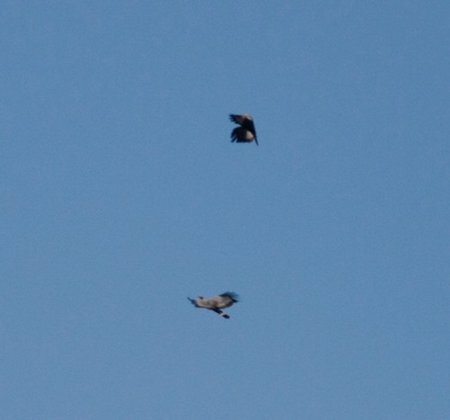
African Harrier Hawks displaying
Roberts reports the following regarding such displays:
In breeding display, 1 (sometimes both) of pair sours high in air, in slow and buoyant flight, usually silent. Sometimes makes shallow undulations with exaggerated wing fluttering. Sometimes male stalls, falls backwards and drops into a dive; may dive on soaring female, who turns onto her back and extends legs so that they briefly tough claws. Such flights average 20 minutes (11 – 33 minutes, n = 10).
In-between soaring Honeys and displaying Harrier Hawks there were a smattering of Steppe Buzzards (probably 5 individual birds in total), a lone Rock Kestrel, a distant Booted Eagle, an immature African Fish Eagle (below) and at least one vocal Forest Buzzard. I was chuffed with the Fish Eagle, it’s only the second time I’ve seen this species at Kirstenbosch and interestingly the last time it was also an immature.
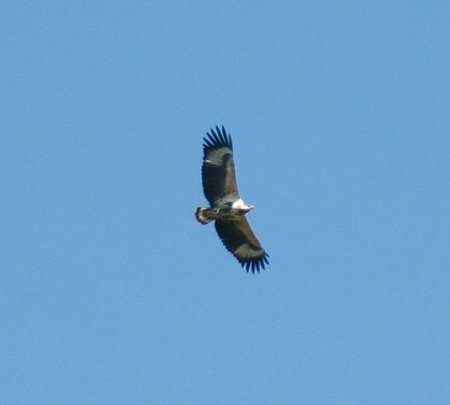
African Fish Eagle (immature)
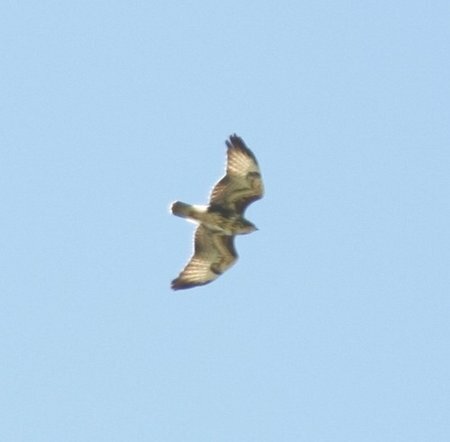
Forest Buzzard
Thinking the morning couldn’t get any better, whilst photographing a passing buzzard my attention was drawn to a soaring falcon, which struck me by its long-tailed and winged appearance and its dissimilarity with expected falco species. The bird was fairly distant, but I managed to snap a few record shots, which I circulated for comment here earlier this week. Below are two of the images.
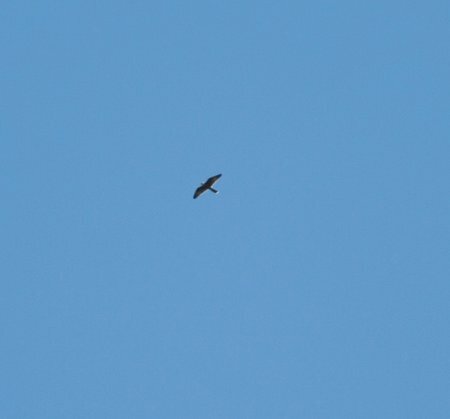

My suspicions at the time, and now following input from a variety of raptor experts, is that the bird may have been an Eleonora’s Falcon. Other suggestions from people have included Lanner, Peregrine and European Hobby. Out of interest, John Graham recorded an Eleonora’s Falcon at Kirstenbosch back in 2006 and managed to grab a few shots of the soaring bird. Subsequent to his sighting he created this series of photos, which includes his Kirstenbosch bird on the left and then an Eleonora’s image from the web for comparison.
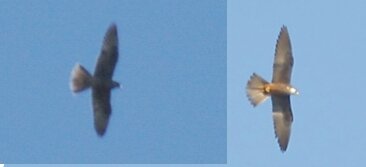
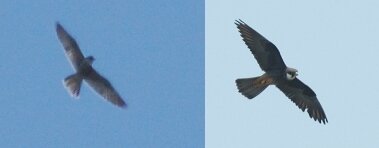
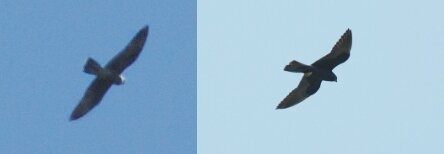
I also consulted raptor expert Dick Forsman (www.dickforsman.com) and this was his response:
I can only agree with you, that the bird in the image is a young dark morph Eleonora’s Falcon. The falcon is young because of its prominent white tail-tip and trailing edge to the wing. Identifying it as an Eleonora’s is to push it a bit, as some juv Hobbies can look extremely similar when viewed against the light and in slightly blurred images like this. However, in this case I believe, that what we see is also the actual truth.
So, all in all it was an action-packed morning that produced no less than 8 raptor species. Raptor watching can be a pot-luck affair, but I’ll certainly be putting in some more time this weekend so feel free to join me if you’re keen to catch up with some of the Peninsula’s raptors.
David Winter
Kirstenbosch bird list: Sombre Greenbul, Cape Sugarbird, Swee Waxbill, Cape Canary, Orange-breasted Sunbird, Cape White-eye, Forest Canary, Steppe Buzzard, Forest Buzzard, Honey Buzzard, Booted Eagle, Rock Kestrel, African Harrier Hawk, African Fish-Eagle, Southern Boubou, Paradise Flycatcher, Cape Batis, Black Saw-wing, Bar-throated Apalis, Cape Robin-Chat, Red-winged Starling.
January 17th, 2011
While raptor watching at Kirstenbosch Botanical Gardens on Saturday I snapped these poor images of a large falcon. It unfortunately did not hang around and was last seen heading south in the direction of Cecilia Forest. My suspicions, and the opinions of a couple of raptor experts, point towards Eleonora’s Falcon. Does anyone else perhaps have an opinion regarding its identification?



David Winter
March 18th, 2010
Per Holmen reports that the Yellow Wagtail was still present at Strandfontein Sewage Works yesterday. Below is his original note from Cape Birdnet and one of his cracking photos of the bird:
I just got back from Caprivi (trip report will shortly follow) yesterday and realized I have a lot of Western Cape catching up to do. I went to Strandfontein today and found the Yellow Wagtail on the road between P2 and P3.

Per also spotted a young Cape Gannet in P2. I wonder if the recent strong winds haven’t forced the poor thing to take a breather. The photo below reminds me of a strange record from Kirstenbosch Botanical Gardens in the early 90’s. I received a frantic call from Kirstenbosch head office one morning about a “waterbird” on top of one of the office buildings. I rushed to the scene expecting to find a Gypo or the likes, but rather was presented with a young and rather tired Cape Gannet!

Thanks Per for submitting the note and photos.
David Winter
March 15th, 2010
Jane Angus found a European Oystercatcher at Bot River Lagoon last week, which was enough reason for Margaret Maciver to dash out from Cape Town on Saturday morning to try and catch-up with this bogey bird of 8 years! Below is a photo that Margaret snapped of the rarity:

European Oystercatcher by Margaret Maciver
Here’s Margaret’s note from Cape Birdnet about the trip:
After leaving CT before sunrise this morning, it took me a further two hours to reach Meerensee in Fisherhaven, and nail a bogey bird I’ve been after for years. One beautiful stunning Eurasian Oystercatcher. It was worth the 8 year wait and the long drive right into the sun. You need permission to enter Meerensee to reach the mouth of the river. Shortly after I saw the bird, people began walking on the beach and four or five boats came down river, with people collecting sandprawns? and the bird flew away up river.
Subsequent to Margaret’s email, Pierre Hofmeyr posted the following additional information on Cape Bird Net (14 March 2010):
The Eurasian Oystercatcher, reported from the mouth of the Bot River lagoon on Friday and Saturday, was still showing well this morning (Sunday). It was about 1 km from the river mouth towards Arabella on a strip of sand stretching into the water from the Kleinmond side of the lagoon. It was actively feeding in the company of Black Oystercatchers, Whimbrels and Kelp Gulls and was very approachable. It should be easy to get for anyone still needing it. Surprisingly enough there were no other birders around in the 2 hours we were there.
Thanks Pierre and Margaret for the notes and photo.
David Winter
March 14th, 2010
Even the most hardened wader-buff would have enjoyed Sunday’s flurry of rare shorebirds that Seeberg hide at Langebaan lagoon had to offer. Centre stage was dominated by the Hudsonian Godwit, but a single Broad-billed Sandpiper and two Lesser Sand Plovers also kept people on their toes.

I arrived at Langebaan quite late (8h30) by “rare wader twitching” standards to find the tide very low. Both Geelbek and Seeberg were practically deserted of any shorebirds bar distant, hazy specks on the horizon. Things only really started getting exciting after 12pm when I bumped into John Graham at Seeberg hide. The tide was slowly starting to push and within 5 minutes of setting up his scope John had found a Lesser Sand Plover (he had already seen 2 that morning at Seeberg) and a Broad-billed Sandpiper! My photo below is a strong contender for the world’s worst image of a Broad-billed Sandpiper, but the jizz is distinct enough.

The Hudsonian Godwit wasn’t quite so easy. A lot of time was spent scouring all godwits, particularly in flight, but they all seemed to have tails like the bird below – barred!

Eventually, however, the distinctive black tail, wing bar and dark underwing coverts of the Hudsonian were picked out in flight. Again, the below images are dismal, but you get the idea:


Good luck to those chasing any of these birds. A word of advice, check the tide table before you go and make sure you’re there close to high tide.
David Winter
Bird list for the day: Black Harrier, African Marsh Harrier, Cape Francolin, Black-shouldered Kite, Common Titbabbler, Grey-winged Francolin, Pied Starling, Common Starling, Steppe Buzzard, Black-headed Heron, Southern Double-collared Sunbird, Malachite Sunbird, Cape Sparrow, Bokmakierie, Cape Bulbul, Cape Penduline Tit, Karoo Scrub Robin, Barn Swallow, Pearl-breasted Swallow, Little Swift, Kitlitz’s Plover, White-fronted Plover, Terek Sandpiper, Whimbrel, Broad-billed Sandpiper, Lesser Sand Plover, Grey Plover, Bar-tailed Godwit, Hudsonian Godwit, Curlew Sandpiper, Greenshank, Red Knot, Common Ringed Plover, Little Stint, Ruddy Turnstone, Litte Egret, Swift Tern, Little Tern, Common Tern, Caspian Tern, Sanderling, Blacksmith Plover, Great Flamingo.
March 12th, 2010
Below is the photo that Patrick Cardwell took of the Yellow Wagtail yesterday evening.

Yellow Wagtail by Patrick Cardwell
There are many subspecies of Yellow Wagtail – Patrick thinks this bird is Motacilla flava beema. I unfortunately don’t have any books at hand, but Wiki has this to say:
M. f. beema (Sykes, 1832) – Sykes’ Wagtail.
Like flava but head lighter gray, ears washed white; sexes often similar.Breeding: North of lutea, E to Ladakh area. Winter: Indian subcontinent, also E Africa and adjacent Arabia.
Thanks Patrick for posting this superb image!
David Winter
March 12th, 2010
Patrick Cardwell posted a report on Cape Birdnet this morning about seeing a male Yellow Wagtail at Strandfontein yesterday afternoon. Here’s a snippet from his message:
Male in breeding plumage on ash track between P1 & P2 at Strandfontein yesterday afternoon. Bird quite tame and most accommodating from a photographic point of view.
I popped down quickly at lunch time today and the bird was still present, although quite skittish. Below are a few record shots that I managed to take.


As Patrick mentioned, the bird is on the road between P1 and P2 – take a look here if you don’t know where these pans are. Below is a more detailed map of where I saw the bird.

I don’t have a book at hand – any thoughts on what race this bird is?
David Winter
|
|































Recent Comments